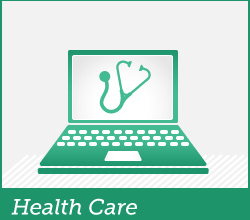It’s always interesting to occasionally look at what is being done outside the US and SAP has developed an EMR that connects to Siemens and other middleware use in Europe. In addition SAP also has their Collaborative E-Care solutions to connect patients and doctors as well for remote monitoring and communication. SAP is a big software manufacturer world wide and I was not aware of their mobile medical records business until of late, and they do have all types of other healthcare and other industry software they sell.
It’s always interesting to occasionally look at what is being done outside the US and SAP has developed an EMR that connects to Siemens and other middleware use in Europe. In addition SAP also has their Collaborative E-Care solutions to connect patients and doctors as well for remote monitoring and communication. SAP is a big software manufacturer world wide and I was not aware of their mobile medical records business until of late, and they do have all types of other healthcare and other industry software they sell. . The next release is to be fully two way as right now it’s pretty much just read only. I think the US has so many EHR vendors here that in this industry perhaps they do a bigger market over seas, but don’t quote me on it as this could be a stepping stone into more business here.
Patients will be able to enter information for their end with the PHR. The format looks nice and easy to read and somewhat reminds me of the screens on a EMR demo from Microsoft from a few years back. From what I am reading and seeing this looks like a mobile user interface that works with several back end data bases, with Siemens being at the top with already having connectivity. BD
Jan Korten, a solutions manager at SAP, and Thilo Berndt, the product development manager for SAP’s mobile healthcare apps, debuted the EMR app during an August 31 Webinar. You can watch the 1-hour presentation and slides here. But in the meantime, here’s an illustrated summary of what they covered.
Ten SAP developers in Europe have been working on the EMR app for the past 3 months. Just finished, the app – iPad today, Android tablets like the Samsung Galaxy Tab tomorrow – is about to be piloted by a trio of European hospitals and then released at the end of October, says Korten
There’s a lot of talk about how a smooth, slick user interface is an important competitive advantage. In healthcare, however, an easy-to-use, powerful UI is mission-critical. While doctors are often very gadget-y, they are also impatient and too busy to deal with a lot of training. An intuitive UI that easily delivers the right information can actually “save lives,” says Korten, a former doctor himself.
The next version will use the Sybase Unwired Platform (SUP) middleware to store more data locally for offline access, handy when doctors are in network “dead spots” within a hospital. It will also be able to download data via 3G.
Here’s the high-level technical architecture: app running on multiple devices (some now, some later), multiple applications and data sources on the back-end, and the SAP Mobility Platform in the middle. This lets the devices access servers via one of three ways: SUP, SAP Gateway, and Netweaver. SAP today ties into Siemens’ i.s.h. medical records platform. According to Korten, the roadmap includes the ability to tie into Picture Archiving and Communications Systems (PACS) and Lab results databases built by 3rd parties.
With Collaborative eCare app, patients can upload data on their symptoms and medicines taken to their doctors while at home. Doctors can adjust dosages and change prescriptions and set reminders for patients to take their medicines via the app. Alerts can even be sent via text message to the patients.






